pergola awnings
What is a pergola awning?
A pergola awning is a type of awning that is usually attached to a pergola. It is used to block sunlight and rain, providing extra protection and privacy in outdoor areas such as patios and gardens. Pergola awnings can be made of different materials such as fabric, aluminum or wood and are available in different sizes and colors. They can be manually or electrically operated and in many cases can be customized to meet the individual needs of the user.
How does it differ from other types of awnings?
Pergola awnings differ from other types of awnings mainly in their installation and use. Unlike traditional awnings, which are attached to the wall or roof of a building, pergola awnings are usually attached to a pergola. A pergola is a freestanding garden or patio canopy that usually consists of posts and beams. A pergola awning can extend the pergola by providing additional shading and rain protection.
Pergola awnings are usually larger than traditional awnings and therefore can cover a larger area. They are also usually more flexible in terms of positioning, as they can usually be placed freely in the room.
Pergola awnings are also aesthetically pleasing and can be an attractive addition to a garden or patio. They are available in different materials, colors and styles and can be adapted to the aesthetics of the house or garden.
Another difference from other types of awnings is that pergola awnings are often used as privacy screens as well, while other types of awnings are often used only for sun and rain protection.
Advantages of using a pergola awning
There are many advantages that come with using a pergola awning:
-
Shading and rain protection: a pergola awning provides additional protection from sunlight and rain, which is especially important if you spend a lot of time outdoors.
-
Flexibility: pergola awnings can be placed freely in space, which means that they are more flexible in terms of positioning than traditional awnings, which are attached to the wall or roof of a building.
-
Aesthetically pleasing, pergola awnings can be an attractive addition to a garden or patio and are available in a variety of materials, colors and styles.
-
Increased privacy: pergola awnings can also be used as privacy screens, which increases outdoor privacy.
-
Expanding the living space: pergola awnings allow you to expand the outdoor living space and turn the garden or terrace into an additional living area.
-
Increased property value: pergola awnings can increase property value as they are seen as an attractive addition to the home and also increase the use of the outdoor space.
-
easy to maintain: pergola awnings usually require little maintenance and are easy to clean.
-
Functionality: pergola awnings can also be equipped with lighting, rain and wind sensors and automatic controls to increase functionality and improve comfort.
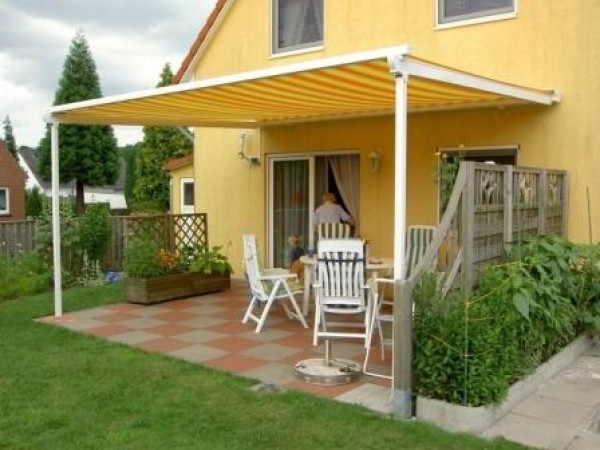
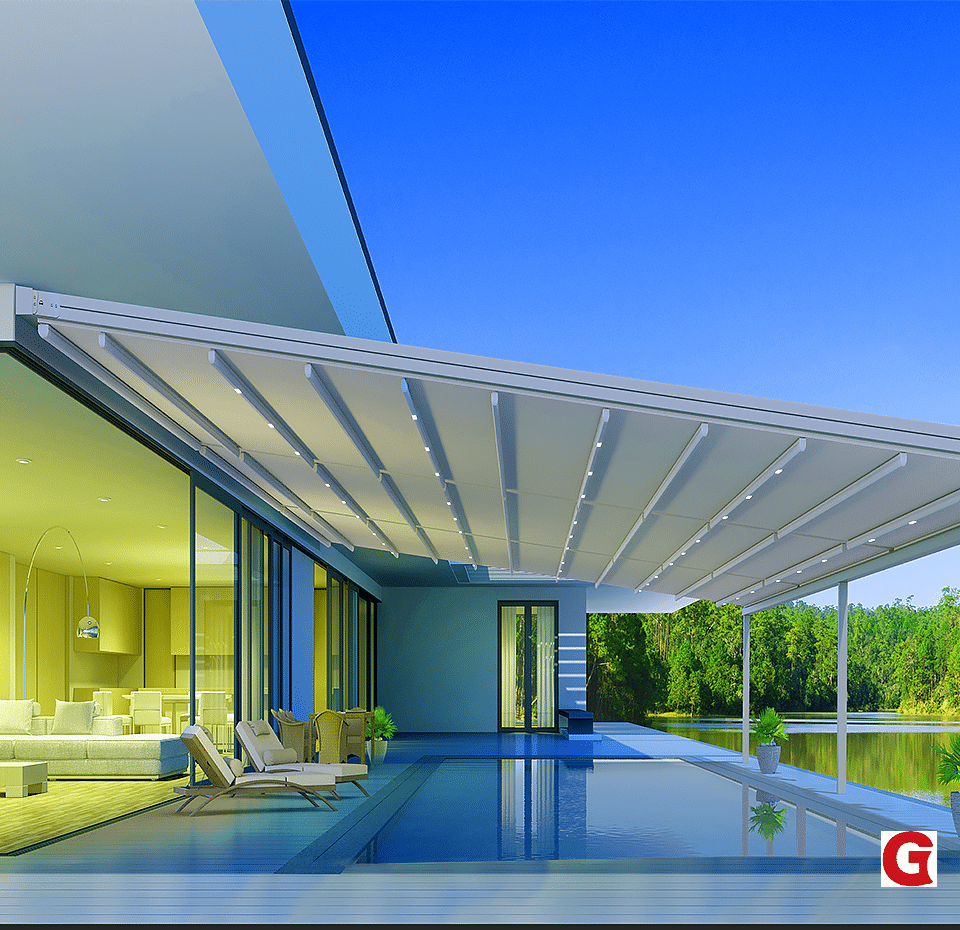
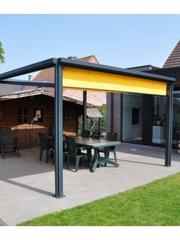
What is the cost of a pergola awning?
The price of a pergola awning can vary depending on the size, material, functionality and brand. A rough estimate for a simple aluminum or steel pergola awning with a size of 4m x 3m and manual operation would be around 2000€ to 4000€. However, if you want a larger awning, electric control, special features like rain and wind sensors, or other customizations, the price can be significantly higher. It is also important to note that the price of installation and assembly of the pergola awning may be additional. It is advisable to obtain quotes from different suppliers and compare the cost of materials, installation and any additional features.
Does a pergola awning require a permit?
Whether a pergola awning requires a permit depends on local codes and regulations. In some regions, a permit may be required if the awning is larger than a certain size or if it is installed on a building that is a listed building. It is important to know local codes and regulations before installing a pergola awning to ensure that you obtain all necessary permits and meet all requirements. It is advisable to contact the appropriate authority to ensure that you obtain all necessary permits and meet all requirements.
Regulation of the incidence of light
A pergola awning can be used to regulate the amount of light entering the interior. The ability to extend and retract the awning allows you to influence the amount of natural light that enters the interior. This can be especially useful for reducing excessive heat and UV rays in the summer, or for making the room brighter when needed. Pergola awnings can also be equipped with various light control and blackout options, such as sun and rain sensors and automatic controls that automatically adjust the awning to the current weather conditions.
There are also special coatings and materials that can be used to regulate the amount of light that passes through the awning. This can help to achieve pleasant and even lighting indoors without creating strong contrasts or glare.
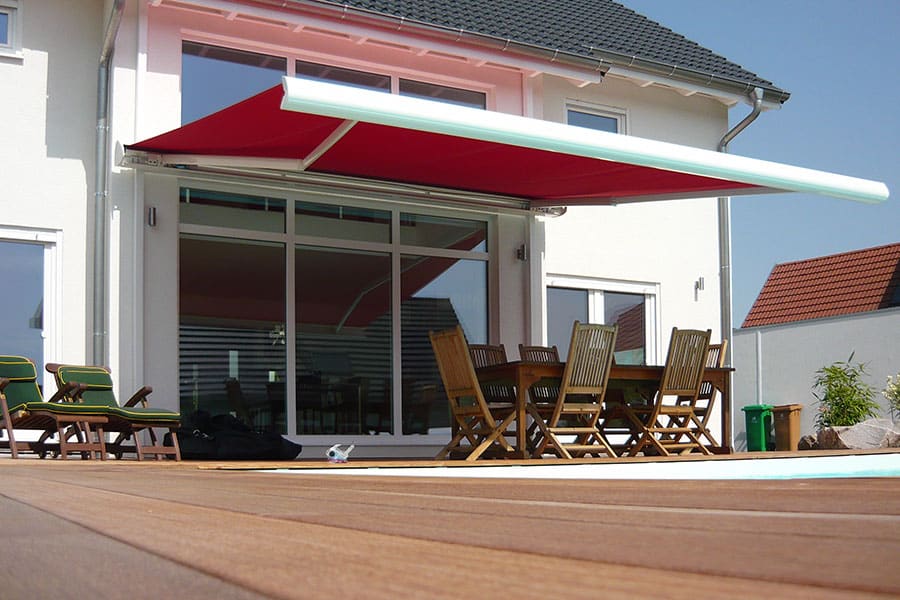
Cassette awnings
electric incl. fully equipped-
Made in Germany - direct from the factory
-
fast delivery times
-
Free shipping within DE
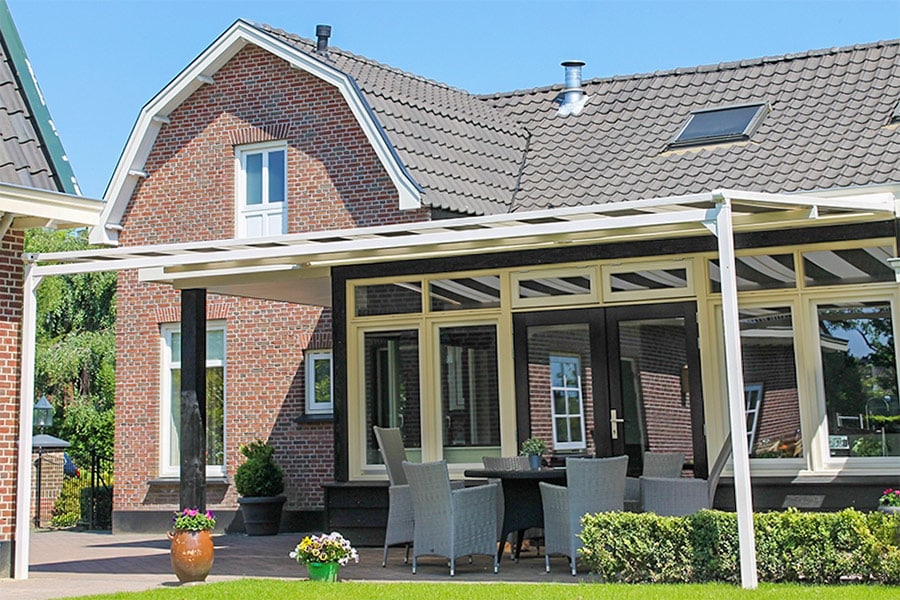
pergola awnings
terrace roof incl. integrated pergola awning-
Ideal for large terraces
-
Up to 600cm width & 500cm projection
-
Can also be used as rain protection

Terrace roof laminated safety glass or multi-wall sheets
Bespoke patio roofs-
Different variants to choose from
-
Made in Germany - direct from the factory
-
made to measure
Protection from UV radiation
A pergola awning can be an effective way to protect against outdoor UV rays. Most awning fabrics are designed to block UV rays, providing natural shade. Some awning fabrics even have a UV protection factor (UPF) of 50+, which means that they block 98% of UV rays. This can help prevent skin cancer and other health problems caused by excessive UV exposure.
Some pergola awnings also have special UV-resistant coatings or materials that additionally help block UV rays. There is also the possibility of installing slats or blinds in the pergola awning to regulate the intensity of light and increase UV protection.
It is important to note that a pergola awning does not provide the same level of protection as UV protective clothing or sunscreen. It is still advisable to protect yourself with proper clothing and sunscreen when spending extended time outdoors.
Increase flexibility
A pergola awning can increase outdoor flexibility by expanding outdoor living space and enhancing outdoor use. The ability to extend and retract the awning allows you to regulate the amount of natural light and protection from the elements, making the room lighter or darker as needed.
Pergola awnings can also be equipped with various features such as rain and wind sensors and automatic controls that automatically adjust the awning to the current weather conditions. This increases flexibility by eliminating the need to manually extend or retract the awning.
Installing a pergola awning also increases the flexibility of the garden or terrace, as it creates an additional living area protected from rain and sunlight. This allows more time to be spent outdoors enjoying different activities such as eating, relaxing or entertaining.
Architecture increase
A pergola awning can elevate outdoor architecture by providing an attractive complement to an existing pergola or building. It can be used to create an aesthetic link between the interior and exterior, creating a harmonious connection between the building and the environment.
Pergola awnings can also be used to extend an existing pergola to create a larger outdoor area protected from sunlight and rain. They can also be used to extend an existing patio or balcony to create more outdoor living space.
Pergola awnings can also be available in a variety of materials, colors and styles to match the aesthetics of the home or garden. They can also be customized to meet the individual needs of the user, such as the choice of manual or electric control, slats.
Disadvantages of using a pergola awning
Like any living space expansion, there are drawbacks to using a pergola awning. Some of them are:
-
Cost: Purchasing and installing a pergola awning can be expensive, especially if you have special requirements or need a larger awning.
-
Maintenance: pergola awnings usually require regular maintenance to remain in good condition. This can lead to the need for regular cleaning and repairs.
-
Weather influences: Pergola awnings can be damaged by strong winds or other weather conditions. If the awning is not properly secured, it may even break off.
-
Maintenance of electronic controls : If the pergola awning is electrically controlled, it may be necessary to regularly maintain the controls and perform any repairs.
-
Maintenance of materials: The materials that make up the pergola awning can be affected by weather conditions and may show signs of aging.
-
Space requirements: a pergola awning requires space to be set up and can increase the amount of outdoor space required.
It is important to weigh the pros and cons before deciding to install a pergola awning to ensure that it meets expectations and meets the requirements.
Recommendations for the selection and use of a pergola awning
When choosing and using a pergola awning. Here are some recommendations:
-
Size: consider the size of the area you want to cover and choose an awning large enough to create the shade area you want.
-
Material: Choose a material that is sturdy, durable and well resistant to weathering and UV rays.
-
Functionality: consider whether you need additional features such as electrical controls, rain and wind sensors, or automatic controls to increase functionality.
-
Design: Choose a design that matches the architecture of the building and suits your personal taste.
-
Space requirements: Consider the space
Choose a high quality manufacturer
When buying a pergola awning, it is important to choose a quality manufacturer. Some things to look out for are:
-
Experience: choose a manufacturer that has many years of experience in the production of pergola awnings.
-
Reputation: research customer reviews and feedback to ensure the manufacturer has a good reputation and that customers are satisfied with the products and service.
-
Warranty: Choose a manufacturer that offers a good warranty on their products to make sure you are covered in case of problems.
-
Customer service: Choose a manufacturer that offers good customer service in case you have questions or problems.
-
Certifications: Look for manufacturers that have certifications confirming that products meet industry requirements and that product quality has been verified.
-
Price comparison: compare prices from different manufacturers to make sure you get a good deal.
- With Metallbau Görres you have a reliable manufacturer in absolute top quality for your pergola awning.
Pergola awnings are a great way to protect the interior from sunlight, rain and snow while enhancing the architecture of the building. However, they also have their disadvantages and it is important to take them into account when choosing and using a pergola awning.
